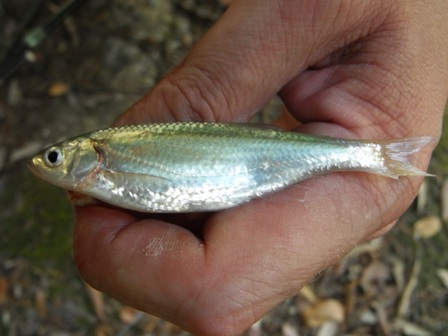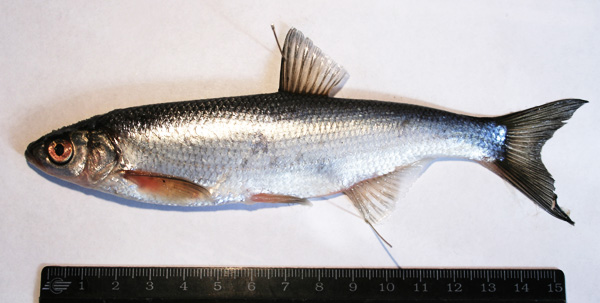|
Pearl Mullet
''Alburnus tarichi'', known as the tarek, pearl mullet, Van fish or Van shah kuli, is a species of cyprinid fish, found only in Turkey, where it is the only fish known to inhabit Lake Van. It is endemic to the Lake Van basin. It is locally known in tr, İnci kefalı/balığı, ku, darex ''darach'', and hy, տառեխ ''taṙex''. The tarek is the 'jewel' of Lake Van in Turkey. Found nowhere else in the world, this fish thrives in the lake's salty and carbonated waters, which are inhospitable to other forms of fresh water and marine fish. In May and June of each year it travels upstream through the lake's tributaries to lay eggs, flying through the air like salmon. Many locals have become accustomed to sticking out bags and catching fish as they jump out of the water, catching so many fish in May–June that they do not have to fish for the rest of the year. Locals prefer to catch the fish during reproduction season, when the females are filled with eggs, which are considered ... [...More Info...] [...Related Items...] OR: [Wikipedia] [Google] [Baidu] |
Johann Anton Güldenstädt
Johann Anton Güldenstädt (26 April 1745 in Riga, Latvia – 23 March 1781 in St. Petersburg, Russia) was a Baltic German natural history, naturalist and explorer in Russian service. Güldenstädt lost both his parents early, and from 1763 onwards studied pharmacy, botany and natural history in Berlin. At the age of 22, he obtained his doctorate in medicine at the Viadrina European University, University of Frankfurt in 1767. In the following year, he joined the Russian Academy of Sciences, Russian Imperial Academy of Sciences' expedition sent by Catherine II of Russia to explore the Russian empire's southern frontier. Güldenstädt travelled through Ukraine and the Astrakhan Oblast, Astrakhan region, as well as the northern Caucasus and Georgia (country), Georgia, both of which were almost entirely beyond the borders of the Russian empire. In March 1775 he returned to St Petersburg. The results of the expedition and Güldenstädt's edited expedition journal were published after ... [...More Info...] [...Related Items...] OR: [Wikipedia] [Google] [Baidu] |
Salmon
Salmon () is the common name for several list of commercially important fish species, commercially important species of euryhaline ray-finned fish from the family (biology), family Salmonidae, which are native to tributary, tributaries of the North Atlantic (genus ''Salmo'') and North Pacific (genus ''Oncorhynchus'') basin. Other closely related fish in the same family include trout, Salvelinus, char, Thymallus, grayling, Freshwater whitefish, whitefish, lenok and Hucho, taimen. Salmon are typically fish migration, anadromous: they hatch in the gravel stream bed, beds of shallow fresh water streams, migrate to the ocean as adults and live like sea fish, then return to fresh water to reproduce. However, populations of several species are restricted to fresh water throughout their lives. Folklore has it that the fish return to the exact spot where they hatched to spawn (biology), spawn, and tracking studies have shown this to be mostly true. A portion of a returning salmon run ma ... [...More Info...] [...Related Items...] OR: [Wikipedia] [Google] [Baidu] |
Fish Described In 1814
Fish are aquatic, craniate, gill-bearing animals that lack limbs with digits. Included in this definition are the living hagfish, lampreys, and cartilaginous and bony fish as well as various extinct related groups. Approximately 95% of living fish species are ray-finned fish, belonging to the class Actinopterygii, with around 99% of those being teleosts. The earliest organisms that can be classified as fish were soft-bodied chordates that first appeared during the Cambrian period. Although they lacked a true spine, they possessed notochords which allowed them to be more agile than their invertebrate counterparts. Fish would continue to evolve through the Paleozoic era, diversifying into a wide variety of forms. Many fish of the Paleozoic developed external armor that protected them from predators. The first fish with jaws appeared in the Silurian period, after which many (such as sharks) became formidable marine predators rather than just the prey of arthropods. Mos ... [...More Info...] [...Related Items...] OR: [Wikipedia] [Google] [Baidu] |
Alburnus
''Alburnus'' is a genus of fish in the family Cyprinidae, the carps and minnows. They are known commonly as bleaks. A group of species in the genus is known as shemayas. The genus occurs in the western Palearctic realm, and the center of diversity is in Turkey. The genus ''Chalcalburnus'' is now part of ''Alburnus''. Species Currently, 45 recognized species are placed in this genus: * ''Alburnus adanensis'' Battalgazi, 1944 (Adana bleak) * †''Alburnus akili'' Battalgil, 1942 (Beyşehir bleak) * ''Alburnus albidus'' O. G. Costa, 1838 (Italian bleak) * '' Alburnus alburnus'' Linnaeus, 1758 (common bleak) * ''Alburnus amirkabiri'' Mousavi-Sabet, Vatandoust, Khataminejad, Eagderi, Abbasi, M. Nasri, Jouladeh & Vasil'eva, 2015 * ''Alburnus arborella'' Bonaparte, 1841 * ''Alburnus atropatenae'' L. S. Berg, 1925 * ''Alburnus attalus'' Özuluğ & Freyhof, 2007 (Bakır shemaya) * '' Alburnus baliki'' Bogutskaya, Küçük & Ünlü, 2000 (Antalya bleak) * '' Alburnu ... [...More Info...] [...Related Items...] OR: [Wikipedia] [Google] [Baidu] |
Near Threatened
A near-threatened species is a species which has been categorized as "Near Threatened" (NT) by the International Union for Conservation of Nature as that may be vulnerable to endangerment in the near future, but it does not currently qualify for the threatened status. The IUCN notes the importance of re-evaluating near-threatened taxon at appropriate intervals. The rationale used for near-threatened taxa usually includes the criteria of vulnerable which are plausible or nearly met, such as reduction in numbers or range. Near-threatened species evaluated from 2001 onwards may also be ones which are dependent on conservation efforts to prevent their becoming threatened, whereas before this conservation-dependent species were given a separate category ("Conservation Dependent"). Additionally, the 402 conservation-dependent taxa may also be considered near-threatened. IUCN Categories and Criteria version 2.3 Before 2001, the IUCN used the version 2.3 Categories and Criteria ... [...More Info...] [...Related Items...] OR: [Wikipedia] [Google] [Baidu] |
IUCN Red List
The International Union for Conservation of Nature (IUCN) Red List of Threatened Species, also known as the IUCN Red List or Red Data Book, founded in 1964, is the world's most comprehensive inventory of the global conservation status of biological species. It uses a set of precise criteria to evaluate the extinction risk of thousands of species and subspecies. These criteria are relevant to all species and all regions of the world. With its strong scientific base, the IUCN Red List is recognized as the most authoritative guide to the status of biological diversity. A series of Regional Red Lists are produced by countries or organizations, which assess the risk of extinction to species within a political management unit. The aim of the IUCN Red List is to convey the urgency of conservation issues to the public and policy makers, as well as help the international community to reduce species extinction. According to IUCN the formally stated goals of the Red List are to provi ... [...More Info...] [...Related Items...] OR: [Wikipedia] [Google] [Baidu] |
Endangered
An endangered species is a species that is very likely to become extinct in the near future, either worldwide or in a particular political jurisdiction. Endangered species may be at risk due to factors such as habitat loss, poaching and invasive species. The International Union for Conservation of Nature (IUCN) Red List lists the global conservation status of many species, and various other agencies assess the status of species within particular areas. Many nations have laws that protect conservation-reliant species which, for example, forbid hunting, restrict land development, or create protected areas. Some endangered species are the target of extensive conservation efforts such as captive breeding and habitat restoration. Human activity is a significant cause in causing some species to become endangered. Conservation status The conservation status of a species indicates the likelihood that it will become extinct. Multiple factors are considered when assessing the s ... [...More Info...] [...Related Items...] OR: [Wikipedia] [Google] [Baidu] |
Erciş
Erciş (; ku, Erdiş; hy, Ականց, Akants, historically , ''Arjesh'') is a town and district located in the Van Province, Turkey on Lake Van. History of Artchesh During Classical Antiquity, the town was known as Arsissa, and Archesh (Arčeš) in Armenian and Arjish in Arabic. The Byzantines knew it as Arzes (Ἂρζες or Ἀρζές) and the 10th-century emperor Constantine VII Porphyrogennetos wrote in his '' De administrando imperio'' (Chapter XLIV) that it was under the rule of the Kaysite emirate of Manzikert. This small district served as the capital city of a number of ruling states. It was the main center of the province of Turuberan as part of the ancient Kingdom of Armenia. The city changed hands on several occasions between the Arabs and the Byzantines, in the early Middle Ages. From the mid 1020s onwards Archesh was governed by the Byzantines. In 1054, it was captured and sacked by the Seljuk Turks commanded by Tuğrul after an eight-day siege. It was for ... [...More Info...] [...Related Items...] OR: [Wikipedia] [Google] [Baidu] |
Egg (biology)
An egg is an organic vessel grown by an animal to carry a possibly fertilized egg cell (a zygote) and to incubate from it an embryo within the egg until the embryo has become an animal fetus that can survive on its own, at which point the animal hatches. Most arthropods such as insects, vertebrates (excluding live-bearing mammals), and mollusks lay eggs, although some, such as scorpions, do not. Reptile eggs, bird eggs, and monotreme eggs are laid out of water and are surrounded by a protective shell, either flexible or inflexible. Eggs laid on land or in nests are usually kept within a warm and favorable temperature range while the embryo grows. When the embryo is adequately developed it hatches, i.e., breaks out of the egg's shell. Some embryos have a temporary egg tooth they use to crack, pip, or break the eggshell or covering. The largest recorded egg is from a whale shark and was in size. Whale shark eggs typically hatch within the mother. At and up to , the o ... [...More Info...] [...Related Items...] OR: [Wikipedia] [Google] [Baidu] |
Chalcalburnus
''Alburnus'' is a genus of fish in the family Cyprinidae, the carps and minnows. They are known commonly as bleaks. A group of species in the genus is known as shemayas. The genus occurs in the western Palearctic realm, and the center of diversity is in Turkey. The genus ''Chalcalburnus'' is now part of ''Alburnus''. Species Currently, 45 recognized species are placed in this genus: * ''Alburnus adanensis'' Battalgazi, 1944 (Adana bleak) * †''Alburnus akili'' Battalgil, 1942 (Beyşehir bleak) * ''Alburnus albidus'' O. G. Costa, 1838 (Italian bleak) * '' Alburnus alburnus'' Linnaeus, 1758 (common bleak) * ''Alburnus amirkabiri'' Mousavi-Sabet, Vatandoust, Khataminejad, Eagderi, Abbasi, M. Nasri, Jouladeh & Vasil'eva, 2015 * ''Alburnus arborella'' Bonaparte, 1841 * ''Alburnus atropatenae'' L. S. Berg, 1925 * ''Alburnus attalus'' Özuluğ & Freyhof, 2007 (Bakır shemaya) * '' Alburnus baliki'' Bogutskaya, Küçük & Ünlü, 2000 (Antalya bleak) * '' Alburnus ... [...More Info...] [...Related Items...] OR: [Wikipedia] [Google] [Baidu] |
Cumhuriyet
''Cumhuriyet'' (; English: " Republic") is the oldest up-market Turkish daily newspaper. It has been described as "the most important independent public interest newspaper in contemporary Turkey". The newspaper was awarded the ''Freedom of Press Prize'' by Reporters Without Borders in 2015 and the Alternative Nobel Prize in 2016. Since 17 October 2005, the newspaper's headquarters have been located in Istanbul's Şişli district, after being the last newspaper to leave the traditional press district of Cağaloğlu. The newspaper also has offices in Ankara and İzmir. The newspaper'advertisementsbefore the 2007 Turkish presidential election and general election with the message "Are you aware of the danger?" were controversial. 's office in Istanbul was the site of a molotov attack in 2008. In 2010, the newspaper was one of the first up-market newspapers in Turkey to abandon the established broadsheet format for the midi-sized Berliner format. In January 2015, the news ... [...More Info...] [...Related Items...] OR: [Wikipedia] [Google] [Baidu] |





